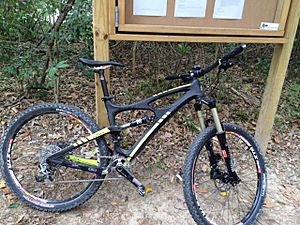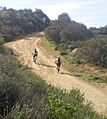Mountain biking facts for kids
Mountain biking is an exciting sport where you ride a bicycle off-road. This often means riding over bumpy paths, rocks, and dirt trails. Mountain biking uses special bikes called mountain bikes. These bikes are built to be super strong and handle tough terrain much better than regular bikes.
There are many different ways to enjoy mountain biking. Some popular types include cross country, trail riding, all mountain (also known as "Enduro"), downhill, freeride, and dirt jumping. Most mountain bikers enjoy trail riding or cross-country styles.
This sport needs you to be fit and have good balance. You also need to be good at handling your bike. More experienced riders can ride down very steep hills and climb up tough slopes. You can go mountain biking almost anywhere, from a local park to a long forest trail. It's important to use your bike's brakes carefully, especially when going downhill. Mountain bikes have many gears to help you ride on different types of ground. Always remember to enjoy your ride without harming the environment!
Contents
Your Mountain Bike and Gear
The Bike Itself
- Mountain bikes are different from other bikes because they are made to be extra tough. They also perform better on rough ground. Most modern mountain bikes have some kind of suspension. This helps absorb bumps and makes the ride smoother. They usually have tires that are 26, 27.5, or 29 inches wide. These tires are often between 1.7 and 2.5 inches thick.
Mountain bikes also have wider handlebars. This gives you a more upright riding position and better control. Their frames are smaller and stronger, often made from thick tubes. The tires usually have a deep tread pattern for grip. The wheels are also stronger than those on regular bikes. Mountain bikes often use hydraulic disc brakes, which give you powerful stopping power. They also have lower gears. This makes it easier to climb steep hills and get over obstacles.
When it comes to pedals, you can use simple platform pedals. With these, you just place your shoes on top. Or, you can use clipless pedals. These require special shoes that clip into the pedal.
Cool Accessories
- Glasses are important to protect your eyes from dirt and debris on the trail. You can get different lenses, like yellow ones for cloudy days or shaded ones for sunny days. Downhill riders often wear goggles, like those used for motocross or snowboarding, with their full-face helmets.
- Shoes for mountain biking usually have grippy soles. They are like hiking boots, so you can walk easily if you need to get off your bike. Unlike road cycling shoes, mountain bike shoes are often more flexible. Many riders also use shoes that work with clipless pedals.
- Clothing should be comfortable for riding and strong enough to handle falls. Regular road cycling clothes are often too delicate. The type of clothes you wear depends on your riding style. Cross-country riders might wear tight shorts and jerseys for comfort and speed. Downhill riders often wear baggy shorts or motocross pants for more protection. All-mountain riders usually wear light, baggy shorts and jerseys since they ride for long periods.
- Hydration systems are key for staying hydrated. You can use simple water bottles or water bags with drinking tubes in a lightweight backpack, like a CamelBak.
- GPS systems can be attached to your handlebars. They help you track your progress on trails.
- Pump is a must-have to inflate your tires if they get low.
- CO2 Inflator with Cartridge can quickly inflate a tubeless tire.
- Bike tools and extra bike tubes are very important. Mountain bikers often find themselves far from help. You might need to fix a flat tire or another small problem yourself.
- High-power lights are great for mountain biking at night.
Staying Safe with Protective Gear
The amount of protective gear riders wear can vary a lot. It depends on how fast they ride, the trail conditions, the weather, and their experience. It also depends on their personal choice. More protection is needed when there's a higher chance of falling or getting hurt.
For most easy rides, a helmet and gloves are usually enough. But for downhill mountain biking, riders often use full-face helmets, goggles, and armored suits or jackets. This extra gear helps protect them from bigger and more frequent crashes.
Images for kids
See also
 In Spanish: Ciclismo de montaña para niños
In Spanish: Ciclismo de montaña para niños














